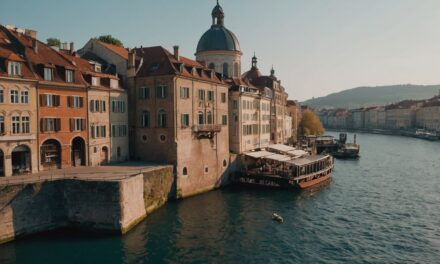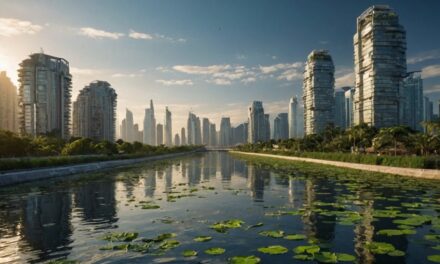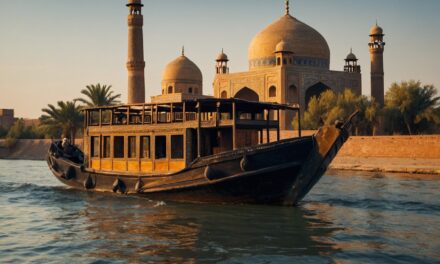Asia, with its rich history and diverse culture, has given rise to some of the world’s most impressive architectural marvels. From ancient temples to modern skyscrapers, Asia’s cities are a treasure trove of architectural wonders that attract millions of visitors each year. The continent’s unique blend of tradition and innovation is reflected in its architectural designs, making it a fascinating destination for architecture enthusiasts and travelers alike.
Key Takeaways
- Asia is home to some of the most impressive architectural wonders in the world.
- Tokyo, Japan offers a unique blend of modern and traditional architecture.
- Shanghai, China boasts a futuristic skyline that is sure to impress.
- Singapore is a leader in green architecture and sustainable design.
- Seoul, South Korea showcases a beautiful blend of ancient and contemporary design.
Tokyo, Japan: A Fusion of Modern and Traditional Architecture
Tokyo, the capital city of Japan, is a perfect example of the fusion between modern and traditional architecture. Its skyline is a blend of towering skyscrapers and traditional Japanese buildings. The city’s iconic landmarks include the Tokyo Tower, a symbol of modernity that offers breathtaking views of the city, and the Meiji Shrine, a serene oasis in the heart of Tokyo that showcases traditional Japanese architecture. Another must-visit landmark is the Imperial Palace, which combines traditional Japanese design with modern elements.
Shanghai, China: The Skyline of the Future
Shanghai, the largest city in China, is a marvel of modern architecture that reflects the country’s rapid economic growth. The city’s futuristic skyline is a sight to behold, with towering skyscrapers that dominate the horizon. The Oriental Pearl Tower, an iconic symbol of Shanghai, is a must-see attraction that offers breathtaking panoramic views of the cityscape. The Shanghai Tower, one of the tallest buildings in the world, is another impressive landmark that showcases China’s engineering prowess. The Shanghai World Financial Center is yet another architectural marvel that demonstrates China’s ambition and innovation in design. With its sleek and modern design, Shanghai is a city that truly embodies the spirit of progress and innovation.
Singapore: A City of Green Architecture
Singapore is renowned for its innovative green architecture and sustainable design. The city’s commitment to environmental sustainability is evident in its famous landmarks such as Marina Bay Sands, an iconic hotel complex that features a rooftop garden with stunning views of the city. Gardens by the Bay is another must-visit attraction, with its futuristic Supertrees and sustainable design principles. The National Gallery Singapore, housed in a beautifully restored colonial building, showcases the city’s blend of old and new architectural styles.
Seoul, South Korea: A Blend of Ancient and Contemporary Design
Seoul, the capital city of South Korea, is a fascinating blend of ancient Korean design and contemporary Western influences. The city’s most famous landmarks include the Gyeongbokgung Palace, a majestic structure that dates back to the Joseon Dynasty, and the N Seoul Tower, an iconic landmark that offers panoramic views of the city. The Dongdaemun Design Plaza is another architectural gem, with its futuristic design and innovative use of materials.
Bangkok, Thailand: A City of Temples and Palaces
Bangkok, the capital city of Thailand, is known for its ornate temples and grand palaces. The city’s most famous landmarks include the Wat Phra Kaew, also known as the Temple of the Emerald Buddha, which is considered one of the most sacred Buddhist sites in Thailand. The Grand Palace is another must-visit attraction, with its intricate architecture and stunning craftsmanship. Wat Arun, or the Temple of Dawn, is another iconic landmark that showcases Bangkok’s rich architectural heritage.
Mumbai, India: A Melting Pot of Architectural Styles
Mumbai, India’s financial capital, is a melting pot of architectural styles that reflect its diverse cultural influences. The city’s most famous landmarks include the Gateway of India, a monumental arch that welcomes visitors to the city, and the Chhatrapati Shivaji Terminus, a UNESCO World Heritage Site that showcases Victorian Gothic architecture. The Taj Mahal Palace Hotel is another architectural gem that combines Indian and Moorish influences in its design.
Dubai, United Arab Emirates: A City of Record-Breaking Skyscrapers
Dubai, located in the United Arab Emirates, is known for its record-breaking skyscrapers and luxurious architecture. The city’s most famous landmarks include the Burj Khalifa, the tallest building in the world, which offers breathtaking views of the city from its observation deck. The Burj Al Arab, a sail-shaped hotel, is another iconic landmark that showcases Dubai’s ambition and opulence. The Dubai Mall, one of the largest shopping malls in the world, is also worth a visit for its impressive architecture and design.
Hong Kong: A Vertical City of High-Rises and Skyscrapers
Hong Kong’s architecture is a testament to its status as a global financial hub. The city’s most famous landmarks include the International Commerce Centre, one of the tallest buildings in Hong Kong, and the Bank of China Tower, an iconic skyscraper that stands out in the city’s skyline. Victoria Peak, a popular tourist attraction, offers stunning views of Hong Kong’s high-rise buildings and bustling harbor.
Taipei, Taiwan: A City of Futuristic Buildings and Innovative Design
Taipei, the capital city of Taiwan, is known for its blend of futuristic design and traditional Taiwanese elements. The city’s most famous landmarks include Taipei 101, a towering skyscraper that was once the tallest building in the world. The National Palace Museum houses a vast collection of Chinese artifacts and is housed in a stunning architectural masterpiece. The Chiang Kai-shek Memorial Hall is another iconic landmark that showcases Taipei’s rich history and architectural grandeur.
The Enduring Legacy of Asia’s Architectural Marvels
Asia’s architectural wonders are a testament to the region’s rich history and diverse culture. From ancient temples to modern skyscrapers, Asia’s cities offer a source of inspiration and wonder for architects and travelers alike. Whether it is Tokyo’s fusion of modern and traditional architecture or Dubai’s record-breaking skyscrapers, each city has its unique charm and architectural marvels to explore. As Asia continues to evolve and grow, its architectural landscape will continue to captivate and inspire generations to come.
FAQs
What is the article about?
The article is about the architectural marvels of Asia and serves as a city guide for tourists who are interested in exploring the region’s rich architectural heritage.
Which countries are covered in the article?
The article covers several countries in Asia, including China, Japan, India, Thailand, and Malaysia.
What are some of the architectural marvels mentioned in the article?
The article mentions several architectural marvels, including the Great Wall of China, the Forbidden City, the Taj Mahal, the Petronas Twin Towers, and the Angkor Wat temple complex.
What is the Great Wall of China?
The Great Wall of China is a series of fortifications made of stone, brick, tamped earth, wood, and other materials, generally built along an east-to-west line across the historical northern borders of China to protect the Chinese states and empires against the raids and invasions of the various nomadic groups of the Eurasian Steppe.
What is the Forbidden City?
The Forbidden City is a palace complex in central Beijing, China. It served as the imperial palace from the Ming dynasty to the end of the Qing dynasty.
What is the Taj Mahal?
The Taj Mahal is a white marble mausoleum located in Agra, India. It was built by Mughal emperor Shah Jahan in memory of his wife Mumtaz Mahal.
What are the Petronas Twin Towers?
The Petronas Twin Towers are twin skyscrapers in Kuala Lumpur, Malaysia. They were the tallest buildings in the world from 1998 to 2004.
What is the Angkor Wat temple complex?
The Angkor Wat temple complex is a UNESCO World Heritage site located in Siem Reap, Cambodia. It was originally built as a Hindu temple in the early 12th century, but gradually transformed into a Buddhist temple complex.





